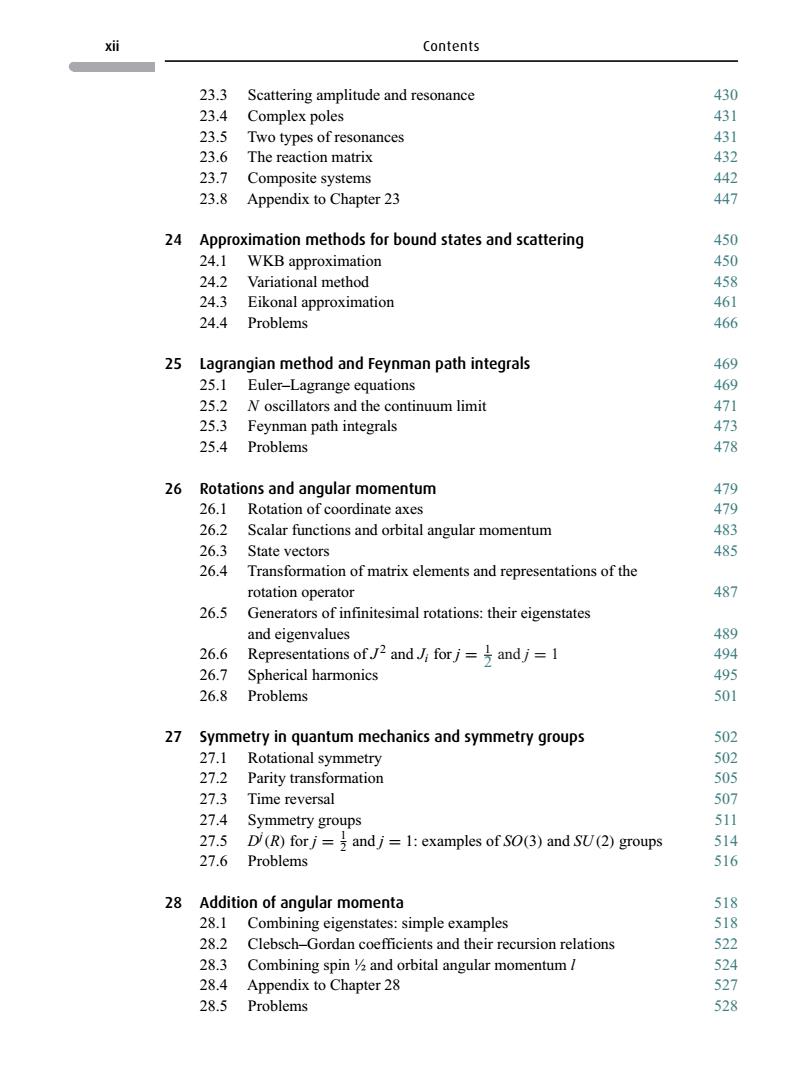正在加载图片...

Contents 23.3 Scattering amplitude and resonance 430 23.4 Complex poles 431 235 Two types of resonances 431 The reaction matrix Composite systems 238 Appendix to Chapter 23 447 24 Approximation methods for bound states and scattering 24.1 WKB approximation 58 24.2 Variational method 458 24.3 Eikonal approximation 461 24.4 Problems 466 25 Lagrangian method and Feynman path integrals 25.1 Euler-Lagrange equations 469 N oscillators and the continuum limit Feynman path integrals 25.4 Problems 478 26 Rotations and angular momentum 479 26.1 Rotation of coordinate axes 479 26.2 Scalar functions and orbital angular momentum 483 26.3 State vectors 485 26.4 Transformation of matrix elements a and representations of the rotation operator 487 26.5 Generators of infinitesimal rotations:their eigenstates and eigenvalues 26.6 Repres tions of J2 and J for j=andj=1 26.7 Spherical harmonics 26.8 Problems 501 27 Symmetry in quantum mechanics and symmetry groups 27.1 Rotational symmetry 27.2 Parity transformation 505 27.3 Time reversal 507 27.4 Symmetry groups 27.5 D/(R)forj=and j=1:examples of SO(3)and SU(2)groups 514 27.6 Problems 516 28 Addition of angular momenta 28.1 Combining eigenstates:simple examples 28.2 Clebsch-Gordan coefficients and their recursion relations 522 28.3 Combining spin %and orbital angular momentum 524 28.4 Appendix to Chapter 28 527 28.5 Problems 528xii Contents 23.3 Scattering amplitude and resonance 430 23.4 Complex poles 431 23.5 Two types of resonances 431 23.6 The reaction matrix 432 23.7 Composite systems 442 23.8 Appendix to Chapter 23 447 24 Approximation methods for bound states and scattering 450 24.1 WKB approximation 450 24.2 Variational method 458 24.3 Eikonal approximation 461 24.4 Problems 466 25 Lagrangian method and Feynman path integrals 469 25.1 Euler–Lagrange equations 469 25.2 N oscillators and the continuum limit 471 25.3 Feynman path integrals 473 25.4 Problems 478 26 Rotations and angular momentum 479 26.1 Rotation of coordinate axes 479 26.2 Scalar functions and orbital angular momentum 483 26.3 State vectors 485 26.4 Transformation of matrix elements and representations of the rotation operator 487 26.5 Generators of infinitesimal rotations: their eigenstates and eigenvalues 489 26.6 Representations of J 2 and Ji for j = 1 2 and j = 1 494 26.7 Spherical harmonics 495 26.8 Problems 501 27 Symmetry in quantum mechanics and symmetry groups 502 27.1 Rotational symmetry 502 27.2 Parity transformation 505 27.3 Time reversal 507 27.4 Symmetry groups 511 27.5 Dj (R) for j = 1 2 and j = 1: examples of SO(3) and SU(2) groups 514 27.6 Problems 516 28 Addition of angular momenta 518 28.1 Combining eigenstates: simple examples 518 28.2 Clebsch–Gordan coefficients and their recursion relations 522 28.3 Combining spin ½ and orbital angular momentum l 524 28.4 Appendix to Chapter 28 527 28.5 Problems 528